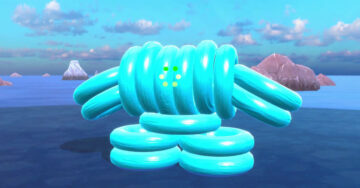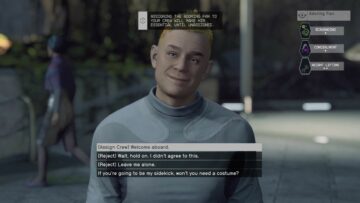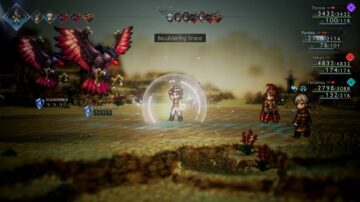Many of Octopath Traveler 2’s most memorable moments are about human connection. Castti, the amnesiac apothecary, learning about her lost past from her previous patients; Hikari, the exiled prince, tracking down and reconnecting with his allies; Agnea, the dancer, wanting to bring joy to people by putting on shows in her mother’s memory.
There’s a lot more to the eight characters and their adventures, but it’s those moments of interpersonal care that stand out, because they cast an unavoidable question on the game: Why aren’t any of these protagonists actually friends?
For dozens of hours, some combination of four out of the eight will be together. While exploring the gorgeous, meticulously drawn 2.5D world, they run together in a neat little row. When fighting, considering their strengths and weaknesses and using their abilities in concert during turn-based battles is crucial. But come to a main story scene, and everyone but the single person directly involved will suddenly disappear.
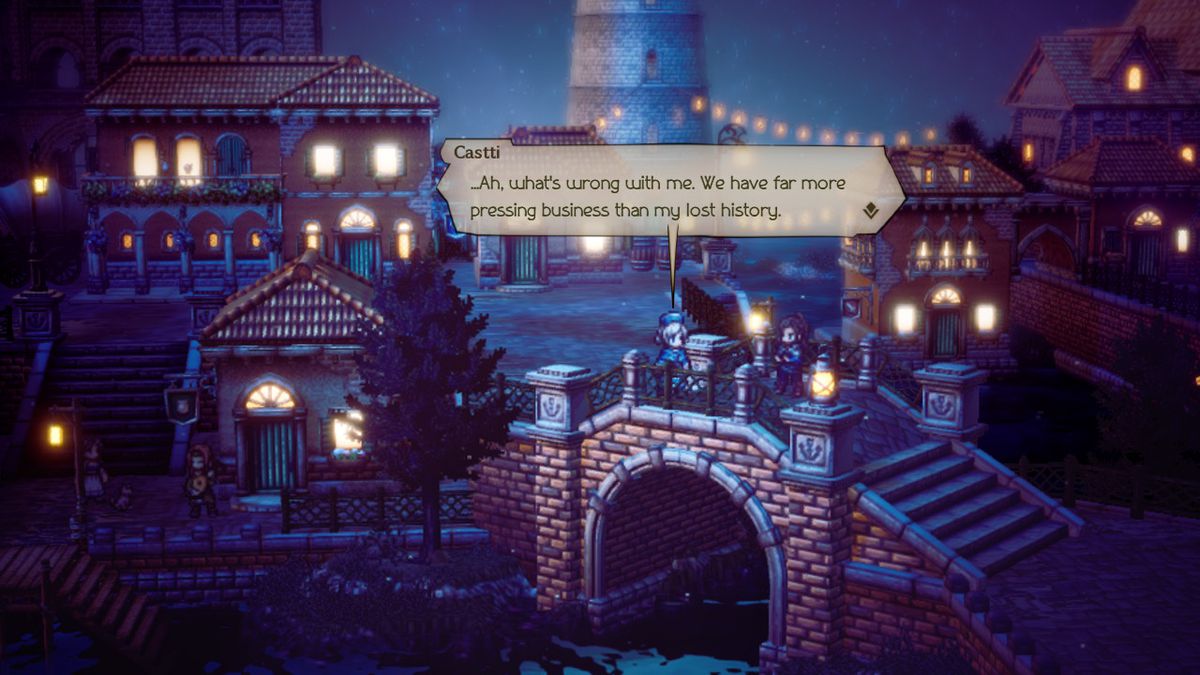
The occasional prompt to see “travel banter,” wherein two characters suddenly stand in a foggy nowhere world overlaid on their previous position and awkwardly chat as if they’ve just recently met, does nothing to alleviate this problem. Neither do the occasional, shallow side stories that see characters’ paths cross. In fact, these feel more jarring than having everybody disappear, because they neither develop nor showcase any believable connections.
The same separation apparently existed in the original Octopath Traveler (which I haven’t played), and I wonder whether it, too, felt so at odds with the story the wider game was telling. Every one of the eight narratives weaves in side characters so skillfully that their relationships with the respective protagonists feel like the core of the game. Unlike the travel banter, their short time on screen is put to good use building histories and personalities for the protagonists. The sprites are also worth highlighting here, with incredible expressivity packed into the tiny figures: mannerisms, gestures, even actions like smoking all add up quickly.
But while the liveliness of the side cast is fantastic, it only further exacerbates the isolation of the main crew from one another. When, for example, characters from an earlier chapter appear to cheer on Agnea at her big dance, the absence of any of her traveling companions feels stark. Conversely, when someone threatens the apothecary Castti and tells her to go to a shady building alone, seeing three other protagonists suddenly appear alongside her undermines the tension.
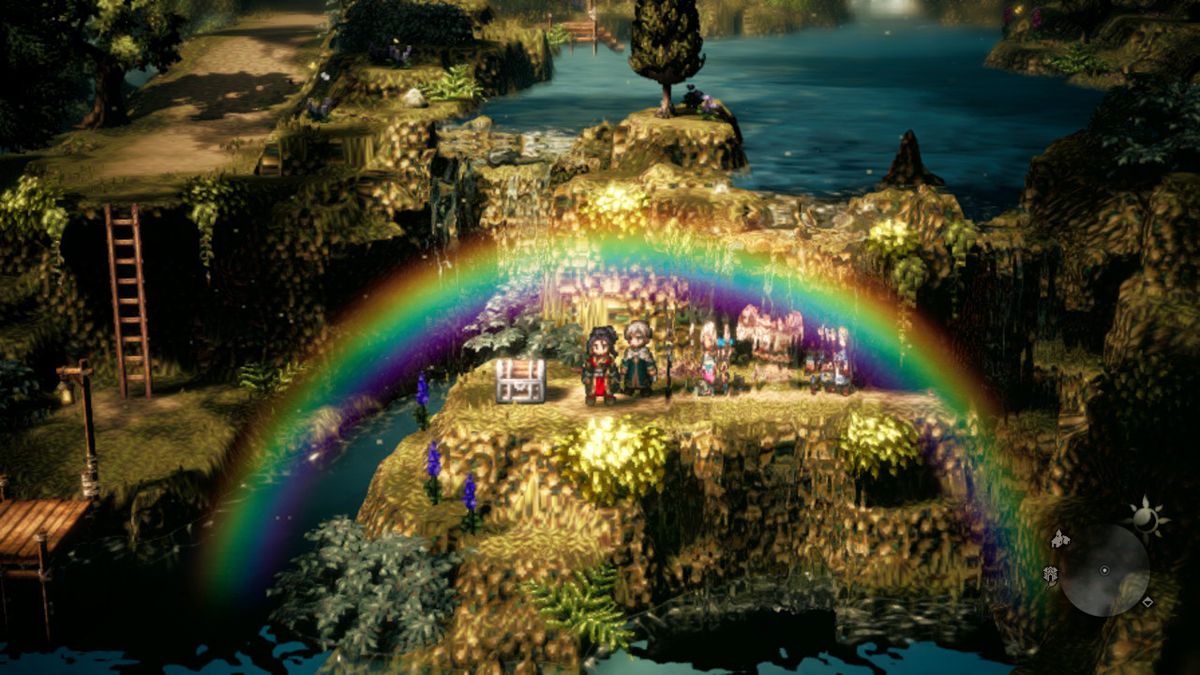
It’s a shame, because this odd sense of disconnect aside, Octopath Traveler 2 is compelling. You travel across an expansive world, recruiting new characters and diving into their quests, solving big and small problems for various towns and groups as you go.
The eight tales range from passable (Partitio the merchant’s desire to bring friendly capitalism everywhere he goes is probably the most uneven) to cheesy but enjoyable (Ochette the beastling hunter might not have much of a character arc, but she’s cute and fun), to cleverly moving (there’s a boss fight in scholar Osvald’s route that uses mechanical storytelling to incredible effect). Taken together, they have an anchoring thematic core about separating personal ambition from damaging greed, while their variety creates a world filled with historical, magical, societal, and religious detail.
That world is also stunning to look at, and if it’s sometimes convoluted to navigate thanks to the winding paths, vague world map, and even vaguer radar, that’s not so much a problem as it is an excuse: to spend more time looking at the sun-dappled trees, marveling at the moonlit snow, or listening to the stellar soundtrack. It also doesn’t matter if traveling takes a bit longer and runs you into more enemies, because you’re going to need to grind anyway. The main chapters’ recommended levels take a big jump in both the mid- and endgame, so that extra XP picked up through backtracking is still going to good use.
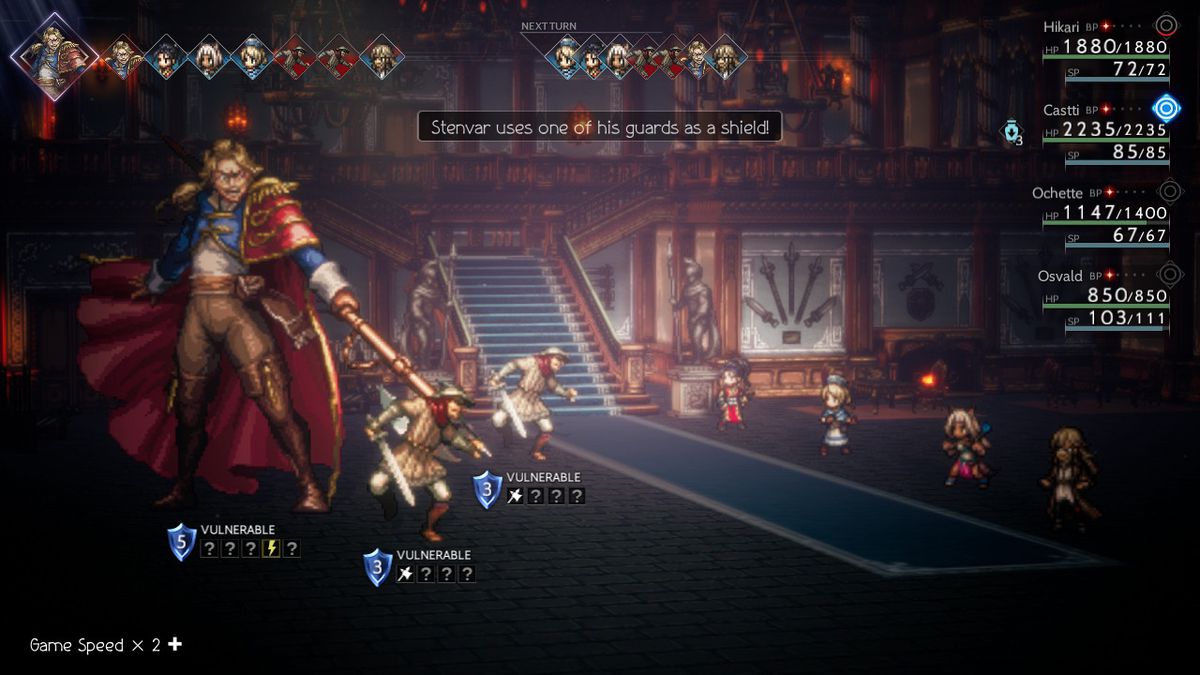
Although this interstitial grinding wears thin toward the end of the game — you stop unlocking interesting abilities at a certain point — the pacing of the chapters themselves is snappy. Most last an hour or two and involve catching up with the multifarious cast of side characters, perhaps using some of the protagonists’ special skills to progress, and then tackling a grand boss fight.
Puzzling your way through these encounters starts well before you get into the fight itself: team composition, equipment, and skills are all crucial. For example, Osvald’s mage powers deal different kinds of elemental damage, but bashing someone with his staff isn’t going to do much physical harm. Hikari, on the other hand, can do massive damage with a single swing, as long as he has a strong enough sword, and perhaps a buff from Castti. Balancing these elements throughout the fight is very satisfying when it works, although losing focus near the end of these long battles can quickly snowball into something devastating. This is especially a problem toward the end of the game, when difficulty spikes become more prevalent and the fights become even longer. (It also didn’t help that I ran into a few UI bugs that prevented important text from telling me what certain abilities and items did.)
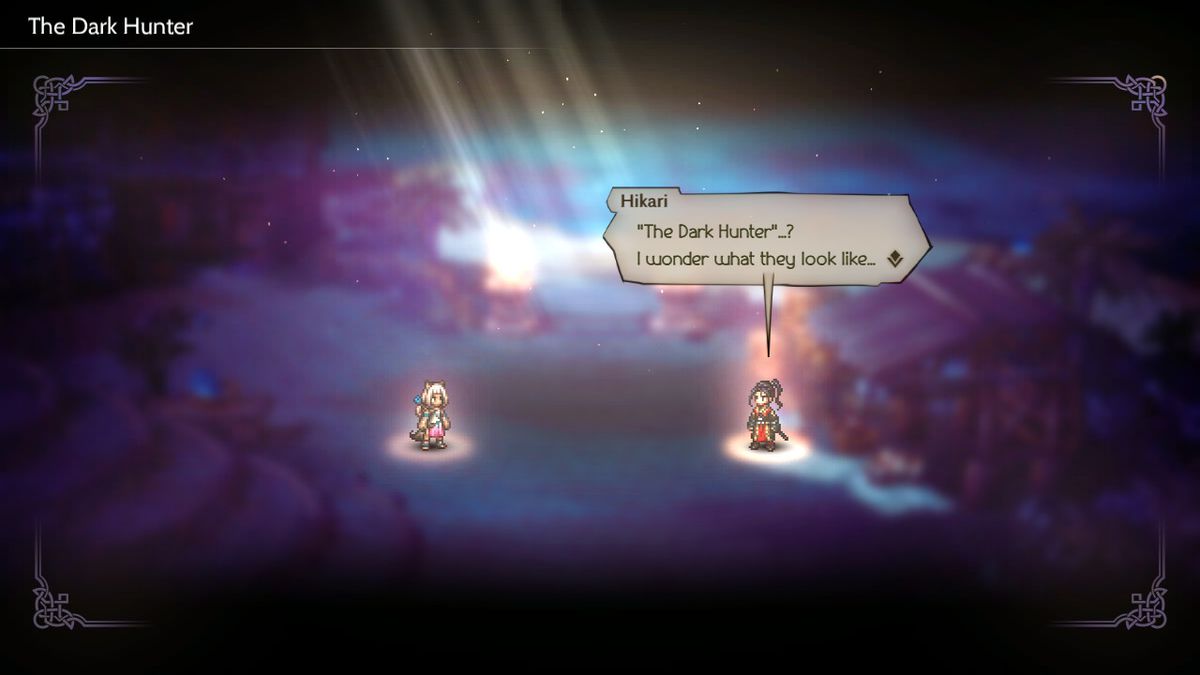
Quibbles aside, these boss fights are generally satisfying conclusions to their chapters, particularly because most bosses’ abilities reflect their characterization in the story. A comically evil medic might focus on debuffing and poisoning the party, while an enemy general trained in swordplay is probably just going to hit very hard and very often.
But even as I enjoy the thought put into each fight’s design, I find myself coming back to the lack of connection between the protagonists. When one protagonist has to fight a childhood friend, their similarities in attacks and strategy is emotionally effective; and there are several similar examples of this attention to mechanical cause and narrative effect. But those poignant moments remain muffled by the gulf between the group — their momentum halted by the silence between the principal actors.
Anyone who’s spent any time in fandom circles knows how a little goes a long way when it comes to filling in the gaps in character relationships. A hand on a shoulder, a passing compliment, a little joke — anything can be fuel for the imagination. There was plenty of time in Octopath Traveler 2, during exploration and combat, when my mind was free to wander and would have done most of the work — if there was any foundation for me to build from. But I can’t help feeling that imaginative fuel wasn’t put into the script to begin with. Without it, Octopath Traveler 2 is beautifully realized, but there’s a hole at its center.
Octopath Traveler 2 will be released on Feb. 24 on PlayStation 4, PlayStation 5, Nintendo Switch, and Windows PC. The game was reviewed on Switch using a pre-release download code provided by Square Enix. Vox Media has affiliate partnerships. These do not influence editorial content, though Vox Media may earn commissions for products purchased via affiliate links. You can find additional information about Polygon’s ethics policy here.
- SEO Powered Content & PR Distribution. Get Amplified Today.
- Platoblockchain. Web3 Metaverse Intelligence. Knowledge Amplified. Access Here.
- Source: https://www.polygon.com/reviews/23602774/octopath-traveler-2-review-switch-ps5-pc-release-date-characters-jrpg
- 1
- 28
- 7
- 9
- a
- abilities
- About
- acquire
- across
- actions
- actors
- actually
- Affiliate
- All
- alleviate
- alone
- alongside
- Although
- ambition
- and
- Another
- appear
- Arc
- Attacks
- attention
- back
- battles
- beautifully
- because
- become
- before
- BEST
- between
- Big
- Bit
- BOSS
- BRIDGE
- bring
- bugs
- build
- Building
- capitalism
- care
- Cause
- Center
- certain
- Chapter
- character
- characters
- circles
- code
- combat
- combination
- come
- coming
- commissions
- companions
- compelling
- concert
- connection
- Connections
- considering
- content
- Core
- creates
- Cross
- crucial
- damaging
- dance
- deal
- Design
- detail
- devastating
- develop
- DID
- different
- Difficulty
- directly
- disappear
- Doesn’t
- down
- download
- dozens
- drawn
- during
- each
- Earlier
- earn
- Editorial
- effect
- Effective
- elements
- enemies
- Enix
- enjoy
- enjoyable
- enough
- equipment
- especially
- Ether (ETH)
- ethics
- Even
- Every
- everyone
- example
- examples
- expansive
- exploration
- Exploring
- extra
- fantastic
- few
- fight
- fighting
- fights
- Figures
- filled
- Find
- Focus
- Foundation
- Free
- friend
- friendly
- friends
- from
- Fuel
- fun
- further
- game
- General
- generally
- get
- Go
- Goes
- going
- good
- great
- Greed
- grinding
- Group
- Group’s
- hand
- Hard
- having
- help
- here
- highlighting
- historical
- Hit
- Hole
- HOURS
- How
- HTTPS
- human
- imagination
- important
- in
- incredible
- influence
- information
- interesting
- involve
- involved
- isolation
- IT
- items
- itself
- jump
- Lack
- Last
- learning
- levels
- links
- Listening
- little
- liveliness
- Long
- longer
- Look
- looking
- losing
- Lot
- Main
- map
- massive
- Matter
- mechanical
- Media
- Members
- Memory
- meticulously
- might
- mind
- Moments
- Momentum
- more
- most
- moving
- NARRATIVE
- narratives
- Navigate
- Near
- Neat
- Need
- Neither
- New
- Newsletter
- night
- Nintendo
- Nintendo Switch
- Notes
- occasional
- Odds
- ONE
- original
- Other
- packed
- particularly
- partnerships
- party
- Passing
- past
- Patch
- patch notes
- patients
- PC
- People
- perhaps
- person
- personal
- Personalities
- physical
- picked
- plato
- Plato Data Intelligence
- PlatoData
- played
- playstation
- Playstation 4
- PlayStation 5
- Plenty
- Point
- policy
- Polygon
- Polygon’s
- position
- powers
- prevalent
- previous
- Prince
- Principal
- probably
- Problem
- problems
- Products
- Progress
- protagonist
- provided
- purchased
- put
- Putting
- question
- quests
- quickly
- radar
- range
- realized
- recently
- recommended
- recruiting
- reflect
- Relationships
- released
- remain
- respective
- reviewed
- roundup
- Route
- ROW
- Run
- same
- scene
- Screen
- Search
- seeing
- sense
- separating
- several
- shady
- shallow
- Short
- showcase
- Shows
- sign
- Silence
- similar
- similarities
- single
- skills
- small
- Smoking
- snow
- So
- societal
- Solving
- some
- Someone
- something
- Speaks
- special
- spend
- spent
- spikes
- square
- SQUARE ENIX
- Staff
- stand
- stands
- stark
- starts
- Stellar
- Still
- Stop
- Stories
- Story
- storytelling
- Strategy
- strengths
- strong
- Switch
- Take
- takes
- team
- tells
- The
- their
- thematic
- themselves
- things
- thought
- threatens
- three
- Through
- throughout
- time
- to
- together
- too
- toward
- towns
- Tracking
- trained
- travel
- traveler
- Traveling
- Trees
- ui
- unlocking
- use
- variety
- various
- via
- VOX
- vox media
- W3
- wanting
- webp
- weekly
- What
- whether
- which
- while
- wider
- will
- windows
- without
- Work
- works
- world
- worth
- would
- XML
- xp
- Your
- zephyrnet


